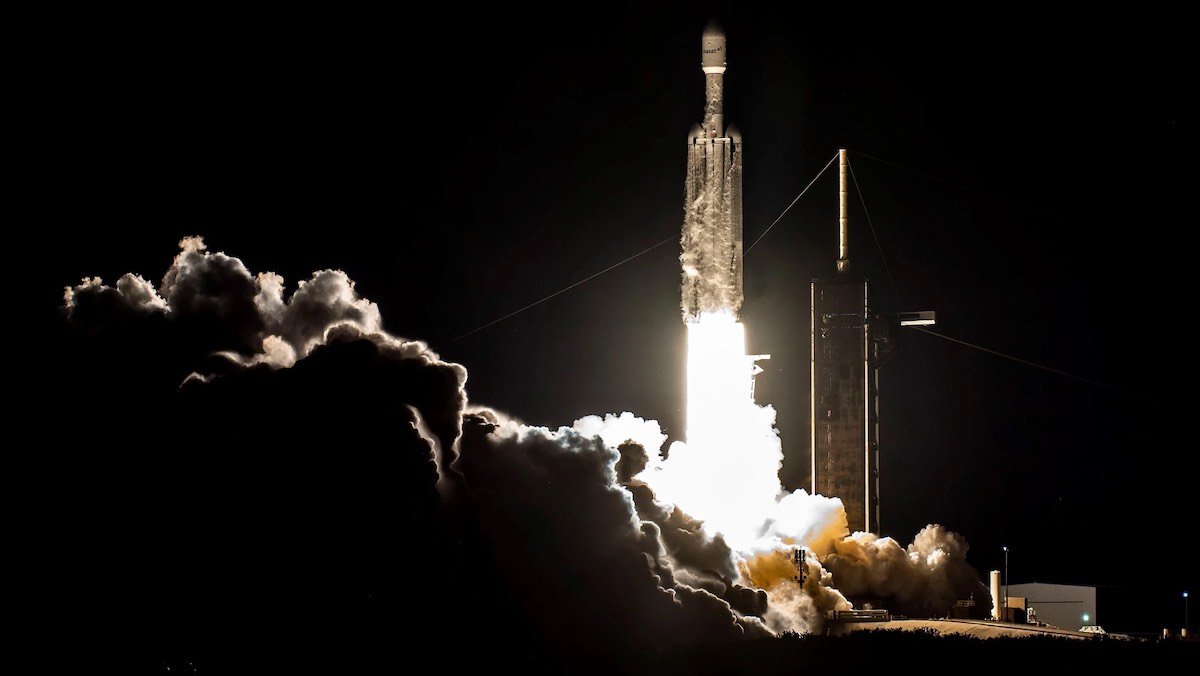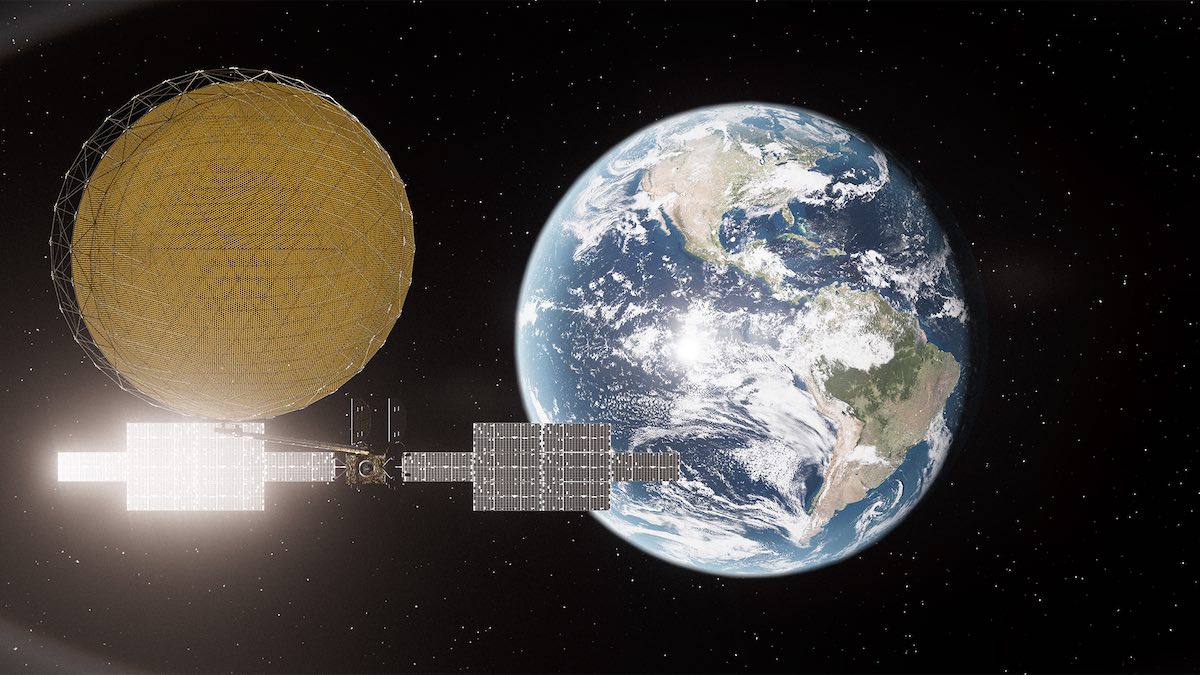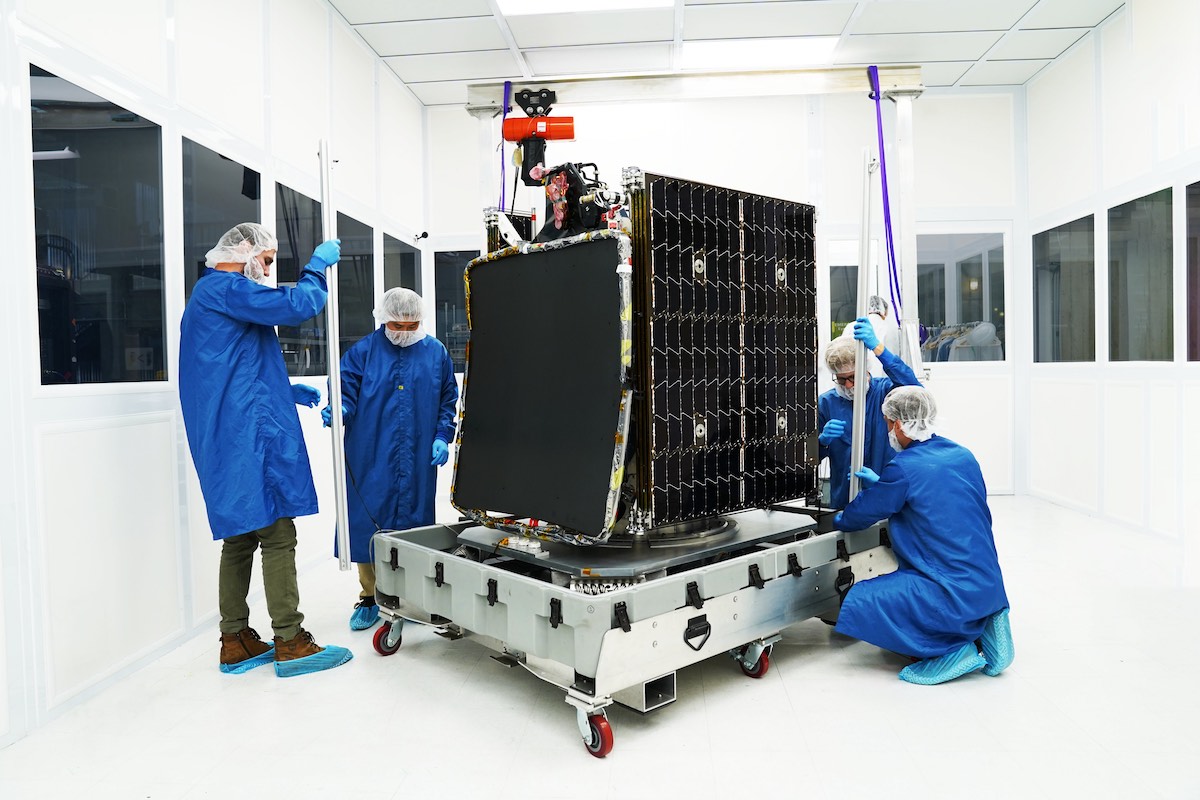Space News & Blog Articles
SpaceX’s Falcon Heavy hits bullseye with ascent to near-geosynchronous orbit
 SpaceX’s Falcon Heavy rocket lifts off from pad 39A at NASA’s Kennedy Space Center. Credit: SpaceX
SpaceX’s Falcon Heavy rocket lifts off from pad 39A at NASA’s Kennedy Space Center. Credit: SpaceX
A SpaceX Falcon Heavy rocket thundered into the sky over Florida’s Space Coast Sunday night and deployed a sophisticated internet satellite for Viasat into a circular orbit more than 20,000 miles over the equator, delivering for a competitor to SpaceX’s own Starlink broadband network.
Completing nearly five hours of engine burns and delicate in-orbit maneuvers, the Falcon Heavy’s upper stage released the ViaSat 3 Americas satellite and two rideshare payloads into a near-geosynchronous orbit early Monday. Orbital data released by the U.S. military confirmed the mission delivered the three satellites into an on-target orbit.
An altitude reading displayed on SpaceX’s live video feed of the launch, presumably relying on real-time telemetry, showed the Falcon Heavy released the satellites for Viasat, Astranis Space Technologies, and Gravity Space at an altitude of 21,512 miles (34,621 kilometers), matching the pre-flight prediction.
The successful launch was the sixth flight of a Falcon Heavy rocket, still the most powerful commercial launcher in service. The Falcon Heavy held the record as the most powerful rocket currently flying until it was surpassed in recent months by NASA’s Space Launch System vehicle and SpaceX’s own Starship mega-rocket.
But the SLS is government-owned, and Starship still needs more test flights to wring out its design and prove its capability.
The Falcon Heavy is available for purchase, and a range of customers — from NASA and the Space Force to SpaceX’s own competitors in the internet-from-space market — have signed up to use the rocket made by combining three Falcon 9 rocket boosters together to form a triple-body launch vehicle.
Viasat, founded in 1986, is one of the satellite operators that have booked a ride on a Falcon Heavy. The company currently provides internet service over North America using a geostationary communications satellite, and the satellite on Sunday’s Falcon Heavy mission is the first of three new-generation ViaSat 3-class spacecraft to expand the company’s internet coverage to global markets.
“Today’s successful launch of ViaSat 3 Americas opens a new chapter in Viasat’s growth,” said Mark Dankberg, Viasat’s chairman and CEO. “This first Americas satellite will multiply our available bandwidth, and enable faster speeds and more coverage — especially for our mobility customers. It’s not just a new satellite, it’s a new way to build broadband satellites.”
SpaceX’s Falcon Heavy, still the world’s most powerful operational commercial rocket, climbs into the sky from Kennedy Space Center in Florida at twilight tonight with the ViaSat 3 Americas internet satellite. https://t.co/qBjZOLufDb pic.twitter.com/aiMJiHoGY4
— Spaceflight Now (@SpaceflightNow) May 1, 2023
SpaceX’s Falcon Heavy took off from pad 39A at NASA’s Kennedy Space Center at 8:26 p.m. EDT Sunday (0026 UTC Monday), firing 27 kerosene-fueled Merlin engines to produce 5.1 million pounds of thrust at full power.
The 27 engines steered the rocket on a trajectory due east from Florida’s coastline. The two side boosters shut down and jettisoned about three minutes into the mission. Then the center core booster throttled up its nine engines, which fired at partial power to conserve fuel in the first few minutes of the mission.
The core stage switched off its engines and separated about four minutes into the flight, then an upper stage took over for three burns to first place the ViaSat 3 Americas satellite into a parking orbit, then to propel it into a higher transfer orbit. Finally, a final burn more than four hours after liftoff guided the rocket into a circular orbit more than 20,000 miles high, raising the rocket’s low point, or perigee, while also moving the orbit directly over the equator.
Then the Falcon Heavy released its three commercial payloads one-by-one.
ViaSat 3 Americas was first off the rocket. The spacecraft, which weighed more than 13,000 pounds (6 metric tons) at launch, radioed ground teams a few minutes later, confirming the satellite was healthy following its ride into orbit.
The heavy weight of the ViaSat 3 Americas satellite, coupled with Viasat’s desire to launch it into an orbit close to its final operating altitude to speed its entry into service, meant SpaceX had to dispose of all three Falcon Heavy first stage boosters Sunday night. The high-performance mission required all of the rocket’s propellant, leaving no leftover supply for landing and recovery maneuvers.
Viasat has not said how much it paid SpaceX for the launch. Intelsat officials said last year SpaceX charged a premium for a launch where the booster is expended.
The center core for the ViaSat 3 Americas mission was brand new, while the side boosters were reused from previous SpaceX missions.
Separation of the ViaSat 3 Americas satellite is confirmed.
The upper stage of SpaceX’s Falcon Heavy has released Viasat’s new high-power internet satellite into a near-geostationary orbit. Next will be solar array, radiator, and antenna deployments.
https://t.co/x0h2tQImUK pic.twitter.com/mYJ0cbBvnJ
— Spaceflight Now (@SpaceflightNow) May 1, 2023
Viasat satellites beam internet signals for underserved consumers, businesses, and governments. Based in Carlsbad, California, Viasat has agreements to provide in-flight WiFi to passengers on Delta Air Lines, American Airlines, United Airlines, Southwest Airlines, JetBlue, and other commercial airlines.
The new ViaSat 3 Americas satellite is as big as a school bus, and its solar panels will unfurl in orbit to a span of 144 feet (44 meters). The solar panels will generate more than 30 kilowatts of power in orbit, more than a quarter the electrical power produced by all the solar arrays on the International Space Station.
ViaSat 3 Americas will rely on all-electric propulsion for fine orbital maneuvers and station-keeping. After separating from the Falcon Heavy rocket, the spacecraft will use its plasma thrusters to raise its orbit the final 700 miles (1,100 kilometers) to geostationary orbit, where its velocity will match the rate of Earth’s rotation.
Viasat built the communications package on the three new ViaSat 3 satellites, and Boeing manufactured the spacecraft platform.
“That is really where the secret is for unleashing the incredible amount of capacity that we’ll have on this satellite which should be over a terabit per second,” said Dave Ryan, president of space and commercial networks at Viasat.
“ViaSat 2 (launched in 2017) had set the record at a little less than 300 gigabits per second, until very recently, and then this one will be several times more than that,” Ryan said. “The key is not only will the satellites be able to provide that capacity over a third of the Earth, but they can dynamically move that capacity around.”
Viasat is in heated competition with OneWeb’s internet constellation and SpaceX’s Starlink network, with hundreds and thousands of satellites, respectively. Those constellations fly much closer to Earth than Viasat’s satellites, just a few hundred miles off the surface. SES has a fleet of satellites in its O3b constellation providing broadband connectivity from Medium Earth Orbit about 5,000 miles (8,000 kilometers) over the equator.
SpaceX and OneWeb tout the low latency of their networks, which require internet signals to travel shorter distances than those coming from a satellite in a higher orbit. And the Low Earth Orbit networks have the advantage of reaching customers near the polar regions.
But the low-altitude constellations need many more cheaper, less powerful satellites for global coverage. And ground user terminals need to be able to track satellites one after the other as they fly overhead.
Providing global internet service from geosynchronous orbit requires fewer satellites, but they need to be much larger, more expensive, and more powerful. A consumer connecting with a geosynchronous satellite also can keep their antenna pointed at the same patch of sky.
“Every orbit has its pluses and its minuses,” Ryan said in an interview with CBS News. “Geosynchronous orbit is particularly magical because at that orbit it looks like it is stationary over the ground, so that means a terminal on the ground can literally be bolted in position and just stare at the satellite. It doesn’t have to scan across the sky.”
“Some of our other competition uses phased array terminals for that because, electronically, they can steer from one to the next and follow it, but they’re more complicated, and they’re more expensive,” Ryan said.
“The other advantage of geosynchronous orbit is that you can see a third of the Earth with one satellite, so with one launch, one satellite, you can potentially can connect to a third of the Earth, and that’s the principle behind ViaSat 3. So we have three satellites we’ll be launching.”
The ViaSat 3 satellites will be able to adjust their broadband beams “in a fraction of a second” based on real-time market demand, responding to changes in internet usage based on time of day and other factors, Ryan said.
“We can concentrate capacity in cities, in airports, and have what we call much higher capacity density,” Ryan said. “In other orbits, that’s much, much harder to do, if not impossible.”
The spacecraft has one of the largest antenna reflectors ever sent into space, with an area larger than a football field. The mesh-like antenna, produced by Northrop Grumman, will take “literally days” to carefully unfold once the satellite is on station in geosynchronous orbit, Ryan said in a pre-launch interview.
That will allow the ViaSat 3 Americas spacecraft to hover over the same geographic position along the equator at 88.9 degrees west longitude, providing coverage over North and South America and adjacent maritime regions. Viasat and Boeing are working on two more satellites to provide similar internet service over Europe, North Africa, and the Middle East, and the Asia-Pacific region.
Those next ViaSat 3 satellite will launch in late 2023 on a United Launch Alliance Atlas 5 rocket. The third ViaSat 3 spacecraft was originally booked to fly on a European Ariane 6 rocket, but Ryan said Viasat is looking for another launch provider after the Ariane 6 encountered delays.
 Artist’s illustration of the ViaSat 3 satellite with its solar arrays and reflector antenna deployed. Credit: Viasat
Artist’s illustration of the ViaSat 3 satellite with its solar arrays and reflector antenna deployed. Credit: Viasat
Smaller rideshare communications satellites for Astranis and Gravity Space, both commercial startups, hitched a ride to orbit on the Falcon Heavy rocket Sunday night.
Astranis’s satellite, called Arcturus with a launch weight around 660 pounds (300 pounds), will provide broadband internet services to Alaska
John Gedmark, CEO of Astranis, tweeted that the Arcturus satellite, also known as Aurora 4A, was in good shape following the launch Sunday night.
“The Astranis spacecraft separated on schedule and we have achieved contact,” Gedmark tweeted. “So far: confirmed successful solar array and antenna deployments. Voltage readings good. Batteries charged. Systems nominal.”
All the communications capacity on Astranis’s first satellite has been purchased by Pacific Dataport for internet coverage across Alaska. Astranis has other similar-size spacecraft in development for other customers.
Gravity Space’s microsatellite will reportedly help an Indonesian company retain regulatory rights to an orbital slot in geostationary orbit with the International Telecommunication Union, which doles out geostationary positions to commercial satellite operators.
Mark Thompson, CEO of Gravity Space, said his company’s GS-1 spacecraft will be the first commercial CubeSat-based satellite in geosynchronous orbit. Along with its mission to help ensure orbital slot reservations, the GS-1 spacecraft will also have a mission focused on “internet of things” technologies and will perform an rendezvous and docking experiment, Thompson wrote in an email reply to questions from Spaceflight Now.
Thompson said the GS-1 spacecraft had a launch mass of around 55 pounds, or 25 kilograms.
 Astranis’s first satellite, named Arcturus, will provide internet coverage to Alaska for Pacific Dataport. Credit: Astranis
Astranis’s first satellite, named Arcturus, will provide internet coverage to Alaska for Pacific Dataport. Credit: Astranis
The launch of SpaceX’s sixth Falcon Heavy was delayed nearly a month, first due to a problem with the rocket’s upper stage, then by a decision by SpaceX managers to swap out multiple engines following a test-firing at Kennedy Space Center on April 13.
SpaceX called off a launch opportunity Wednesday for a data review, then a scrubbed launch countdown Thursday due to severe weather. Another Falcon Heavy countdown Friday aborted a minute before liftoff for an unspecified reason.
The delay in the Falcon Heavy launch will have a ripple effect on two upcoming SpaceX launches from pad 39A to send a crew and cargo to the International Space Station.
The launch of Axiom Space’s second commercial crew mission, called Ax-2, on a Falcon 9 rocket and Crew Dragon spacecraft from pad 39A has been postponed from May 8 to no earlier than mid-to-late May as a result of the Falcon Heavy delay. It takes about three weeks to reconfigure the launch pad and SpaceX’s strongback and transporter/erector structure between a Falcon Heavy mission and a Falcon 9 astronaut mission. That timeline also includes days for a rocket test-firing and crew dress rehearsal, which are not part of every SpaceX mission.
The Ax-2 mission will launch on a nearly two-week flight to the International Space Station. The mission is commanded by former NASA astronaut Peggy Whitson, a veteran of three long-duration flights on the space station and now an employee of Houston-based Axiom. Three private astronaut passengers — one American businessman and two Saudi Arabian government astronauts — will join Whitson for the flight to the station.
After the departure of the Ax-2 mission from the space station in late May, SpaceX plans to launch its 28th cargo resupply flight to the station from pad 39A in early June. A SpaceX Cargo Dragon capsule will ferry a pair of upgraded solar arrays to the space station, along with several tons of scientific experiments and crew supplies.
This email address is being protected from spambots. You need JavaScript enabled to view it. the author.
Follow Stephen Clark on Twitter: @StephenClark1.
When you subscribe to the SpaceZE News Feed, we will send you an e-mail when there are new updates on the site so you wouldn't miss them.

